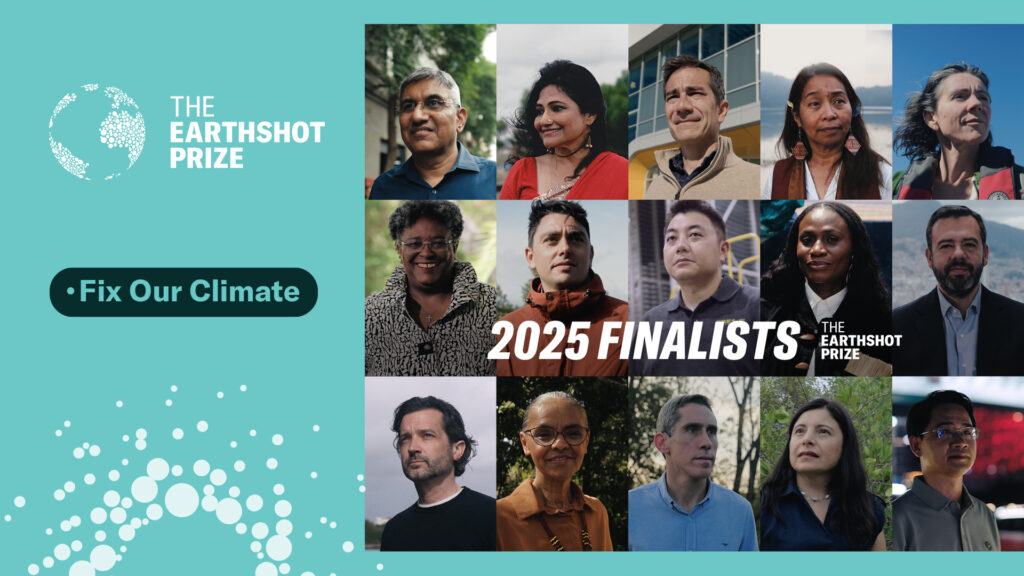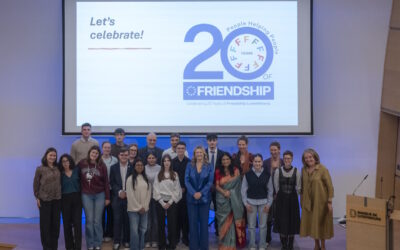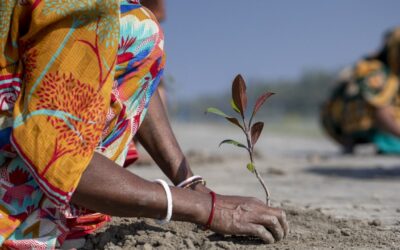The Earthshot Prize, a global environmental prize launched by HRH Prince William to identify, celebrate and back solutions to repair the planet, reaches a pivotal milestone in 2025, marking the halfway point in its ambitious ten-year mission

by Friendship News Desk,
4 October, 2025
Today, the world’s most prestigious and impactful environmental award, The Earthshot Prize, announces its fifth cohort of Finalists, recognising solutions from different geographies, sectors and stages in their life cycle, dedicated to solving our planet’s greatest challenges.
Founded by HRH Prince William in 2020, this year’s Finalists represent exceptional climate leadership across a range of countries, sectors and business models to repair our planet. They include:
- Matter, a British company whose simple washing machine filters remove the greatest cause of microplastics in our ocean.
- Quay Quarter Tower, the world’s first fully ‘upcycled skyscraper’, avoids the carbon disaster that is demolition and construction, transforming a building into a world-class facility;
- Tropical Forest Forever Facility, the boldest initiative ever, is making vital forest preservation more valuable than destruction.
- Barbados, which is on track to become fossil-free by 2030 and is creating billions of dollars of impact on the global stage to support other Large Ocean States.
The 15 finalists are in the running to receive five £1 million prizes across five categories: Revive our Oceans, Fix our Climate, Build a Waste-free World, Protect and Restore Nature and Clean our Air. They join a historic coalition of leaders recognised as driving climate action and inspiring current and future generations to build a better future for people and planet.
The 2025 Winners will be announced at the fifth Earthshot Prize Awards, in Rio de Janeiro, Brazil, on Wednesday, 5 November. The Awards Ceremony will be part of Earthshot Week, with events connecting the world’s most ambitious network of global leaders, innovators, funders, businesses, and communities to create opportunities that restore confidence in our ability to save the planet.
Prince William, Founder and President of The Earthshot Prize, said: “As we reach the halfway point of the Earthshot decade, I am truly inspired by this year’s Finalists, which embody the urgent optimism sitting right at the heart of our mission. In just five years, The Earthshot Prize has shown that the answers to our planet’s greatest challenges not only already exist, but that they are firmly within our grasp.”
The new Finalists join a community of 60 Finalists who are making significant progress in protecting and restoring our natural world. Together, they’ve raised over $500m in funding, protected and restored over 1 million square kilometres of land and ocean, prevented over 250,000 tonnes of waste from reaching landfills and avoided 300,000kg of air pollutants. Their collective efforts have already reduced, avoided or captured over 4.8 million tonnes of CO₂ emissions to fix our climate for future generations. This includes progress by:
- d.light (Clean our Air 2024 Finalist), which has transformed 200 million lives in Africa with its solar-powered products.
- Notpla (Waste Free World 2022 Finalist), which has replaced 21.5 million single-use plastic items with sustainable seaweed packaging, and 11.6 million in 2024.
- Pristine Seas (Revive our Oceans 2021 Finalist) has established 30 of the largest marine protected areas in the world, covering a total area of 6.9 million square kilometres, more than twice the size of India, and helped to create David Attenborough’s groundbreaking Ocean Film.
- Altyn Dala Conservation Initiative (Protect and Restore Nature 2024 Winner), which has helped bring the Saiga Antelope back from the brink of extinction, growing the population from around 40,000 to over 4 million in 20 years. They’ve also reintroduced Przewalski’s horses to Kazakhstan’s wild after more than 200 years.
- Boomitra (Fix Our Climate 2023 Winner), which has worked with over 10,000 farmers in Africa, India, the Americas and Mongolia to adopt regenerative agricultural processes and remove nearly a million cars’ worth of CO2 from the atmosphere.
This year’s cohort was selected from nearly 2,500 nominees submitted by the Prize’s network of 575 nominators from 72 countries. The 15 Finalists were chosen based on assessments undertaken by The Earthshot Prize’s selection partners and Expert Advisory Panel, a global group of more than 100 subject-matter experts with deep backgrounds in conservation, science, technology, business, finance, academia and policy.
As in previous years, the five Winners of this year’s Prize will be selected by HRH Prince William and fellow members of the prestigious Earthshot Prize Council, a diverse group of individuals dedicated to protecting the climate and our natural environment. The Earthshot Prize Council is chaired by The Earthshot Prize Board of Trustees Chair, Dame Christiana Figueres, architect of the Paris Climate Accord.
Christiana Figueres, Chair of The Earthshot Prize, said: “At this pivotal halfway point in this decisive decade for our planet, it is a profound honour to lead The Earthshot Prize in highlighting these impressive solutions. These 15 Finalists have emerged from a rigorous and truly global search, which is designed to be inclusive and representative of the ingenuity rising in all sectors and across all corners of the world. Our Finalists are extraordinary examples of climate leadership and a beacon for the urgent optimism we need to accelerate change.”
Cate Blanchett, The Earthshot Prize Council Member, said: “Five years with The Earthshot Prize has shown me that optimism isn’t abstract – it’s something made real by people bold enough to act now. What I’m especially proud of this year is the way in which entire categories of Finalists are challenging our expected views and behaviours – the way we enjoy fashion, how we buy electronics, protect forests – even wash our clothes – could be fundamentally different by 2030 because of them. To serve on the Prize Council alongside Prince William and my fellow members is a privilege, and I’m excited for the debates ahead as we choose our winners.”
Members of The Earthshot Prize Council are Prince William, Her Majesty Queen Rania Al Abdullah, Cate Blanchett, Indra Nooyi, José Andrés, Wanjira Mathai, Nemonte Nenquimo, Luisa Neubauer, Naoko Yamazaki, Ernest Gibson, and Dr Ngozi Okonjo-Iweala.
Solutions selected align with the five ‘Earthshots’ – simple, ambitious and aspirational goals but more relevant than ever before. The Finalists’ eligibility for one of five £1 million prizes is only the beginning of their Earthshot journey. Each Finalist will receive dedicated mentorship, resources and technical support to help accelerate the growth of their solution during The Earthshot Prize Fellowship Programme.
That support includes access to the Prize’s robust network of influential businesses, investors and climate experts, including The Earthshot Prize’s Global Alliance of Partners, comprised of some of the world’s largest businesses, donors, investors and environmental organisations committed to climate action.
The Earthshot Prize 2025 Finalists
Earthshot 1: Protect and Restore Nature Finalists
re.green, Brazil: Headquartered in Rio de Janeiro, re.green rebuilds critical forests at scale with innovative tech-and community-led action with huge potential for impact. Brazil’s Atlantic Forest is one of the richest natural areas on Earth, yet only 12% of it remains. It’s home to over 150 million people, countless unique species, and serves as a vital carbon sink in the fight against climate change. But right now, destruction is more profitable than preservation.
re.green is changing that. They’re making forest restoration financially viable. With a scalable and sustainable model, re.green generates revenue from high-quality carbon credits and sustainable timber – delivering ecological, social, and financial returns while working toward its goal of restoring one million hectares and capturing 15 million tonnes of CO₂ annually. These efforts have already created over 230 jobs and trained nearly 300 people. Using AI and satellite data, they identify degraded land with the greatest potential in seconds, then restore it with diverse native species.
Tenure Facility, Global: Tenure Facility helps Indigenous Peoples, Afrodescendant Peoples, and local communities to secure their ancestral lands and critical ecosystems for generations to come with funding and legal support. Although these communities manage over half of the world’s land, including many of the most biodiverse and carbon-rich ecosystems on earth, their ownership is often not legally recognised or respected.
The Facility tackles this imbalance by providing the resources communities need to secure their rights and protect their lands and forests from growing threats, ensuring conservation gains are protected for generations, and strengthening community resilience to climate change. Already operating across 20 countries and protecting over 34 million hectares (which is an area the size of Germany), Tenure Facility is proving that when Indigenous communities lead, nature thrives. And this is just the beginning.
Tropical Forest Forever Facility, Global: The Tropical Forest Forever Facility is a proposed blended-finance mechanism to incentivise countries to prevent the deforestation and degradation of tropical forests. It is on the verge of closing the deal of the century, the largest financial strategy in history to protect the planet’s forests, a $125 billion global investment fund which will provide permanent income to countries with tropical rainforests – such as Brazil, Ghana and Indonesia – in exchange for the permanent protection of these forests. In addition to making the payouts to these countries, the fund invests in bonds and other assets that generate returns for investors.
Earthshot 2: Clean Our Air
The city of Bogotá, Colombia: Like many cities around the world, the capital of Colombia, Bogotá, has long faced the challenge of urban air pollution. Since 2018, the city has reduced fine particulate matter – tiny, harmful particles in the air that can affect human lungs and overall health – by 24%, demonstrating that sustained action can make a real difference, even as the population grows. thanks to policies such as expanding its electric bus fleet, adding bike lanes, increasing urban greenery, and tightening freight regulations.
With a strong focus on health equity, Bogotá’s actions have prioritised the most vulnerable communities. Building on this progress, the city is now advancing the Urban Zones for Clean Air, reinforcing its commitment to cleaner air, healthier lives, and climate justice.
The city of Guangzhou, China: Located in southern China, a commercial centre for centuries and home to about 24 million people, Guangzhou is at the forefront of innovation in public transport electrification. Since 2017, with the support of the municipal government, Guangzhou Public Transport Group has been vigorously advancing the comprehensive electrification of the city’s bus and taxi fleets.
This electrification process has advanced at an unprecedented pace; in just eight years, Guangzhou has established a 100% electric bus fleet of 12,000 buses and operated approximately 10,000 electric taxis. Furthermore, the Guangzhou Public Transport Group, which operates the buses and the taxis, has graduated from an energy consumer to a clean energy co-producer by using its retired lithium-iron batteries to store and manage solar and wind power for its own use as well as for the grid. By doing so, Guangzhou has become a leader in EV battery reuse and recycling, helping to reduce the environmental impact of mining and processing lithium, and contributing to a greener and more resilient grid.
The State of Gujarat, India: Gujarat, a major state located in western India and a global economic success story, has put in place a simple and effective solution that allows businesses to continue thriving while reducing air pollution levels. It has pioneered an emissions trading scheme, which was launched and developed in India by the state’s regulatory institution, Gujarat Pollution Control Board and its implementation partner, the Emissions Market Accelerator. This scheme puts a limit on emissions per factory, and if they emit less than their allowance, they can trade their unused quota to other industries needing more. These restrictions on emissions are aligned with the overall cap on the city, which cannot be exceeded – this means industries can work with each other while ensuring the state never exceeds a limit on emissions, creating cleaner air for its citizens to breathe.
The scheme has been piloted successfully in Surat, a major commercial hub and the second largest city in Gujarat, which research shows has reduced particulate matter emissions by about 30%. It has also been introduced in Ahmedabad, Gujarat’s largest city, and there are ongoing discussions to roll it out across various other states of India. The scheme is managed by the Gujarat Pollution Control Board, its implementation partner, and the Emissions Market Accelerator, a joint initiative of the Energy Policy Institute at the University of Chicago in India (EPIC – India) and Abdul Latif Jameel Poverty Action Lab (J-PAL) South Asia.
Earthshot 3: Revive Our Oceans
Matter, UK: Microplastics have become a pervasive pollutant, raising serious concerns for environmental and human health. Matter, a British sustainable technology scale-up, has developed a simple yet transformative solution: a filter designed to catch microplastics that come from our clothes, stopping microplastics from our clothes reaching our rivers, oceans and food systems. Matter’s breakthrough filtration technology, Regen®, is designed to address the world’s largest sources of microplastics emissions, from household washing machines to large-scale textile factories.
Crucially, Regen® delivers both environmental impact and commercial value, a combination Matter believes is essential for widespread adoption and impact at scale. This simple filter will stop the largest driver of microplastic pollution in our oceans at source.
In homes, Matter has a cost-effective filter that can be simply slotted into an existing washing machine. Regen® powers the Bosch and Siemens Microplastic Filters now available in more than 30 European countries. These filters capture up to 97% of microplastics without the need for replacement cartridges, making it easier than ever for everyday people to take action and protect the planet.
In textile factories, Regen® is the first filter designed specifically to target microplastic fibres, preventing them from entering waterways while reducing costs and carbon emissions for producers. By 2030, Matter’s ambition is to deliver enough solutions across both textiles and laundry to capture 15,000 tonnes of microfibre.
Bonds for Ocean Conservation, Global: Some of the richest marine ecosystems in the world are found in countries which are least financially able to protect them, and are the most vulnerable to climate change. Many of these nations are burdened by national debt, leaving them unable to invest in conservation. A game-changing solution is emerging in the form of Bonds for Ocean Conservation, led by the newly formed The Debt for Nature Coalition. Blue Bonds are a financial mechanism that allows countries to refinance expensive debt on better terms, with part of the savings redirected toward long-term marine conservation.
A trailblazing story of just what this solution can achieve is found in the Galápagos Islands, where one debt conversion unlocked over $450 million for ocean conservation. This investment increased government protections for the 6-million-hectare Hermandad Marine Reserve, which is home to sea turtles, dolphins, and sharks, and other endangered marine life.
The High Seas Treaty, Global: Covering over 60% of the world’s ocean, the High Seas remain largely unregulated, despite their critical role in regulating our climate, sustaining biodiversity, and supporting global food security. For decades, there were no clear global rules to protect these areas – until now. The High Seas Treaty – formally known as the BBNJ Agreement – is one of the world’s most ambitious environmental initiatives. After 20 years of hard work, diplomacy and persistent optimism, it is on the verge of entering into force, promising the protection of our ocean on a scale like no other.
This historic achievement is the result of global cooperation between governments, the UN, scientists, Indigenous Peoples, NGOs, civil society, and the High Seas Alliance, a coalition of over 70 organisations driving ratification efforts. In September 2025, the Treaty reached 60 ratifications, triggering its entry into force in early 2026.
The Treaty marks a turning point from unregulated exploitation to collective stewardship of nearly half the planet. It will enable the creation of the first High Seas Marine Protected Areas, helping ecosystems recover and securing ocean resilience for future generations. The High Seas Alliance and partners will continue working to ensure swift implementation and real-world impact as the Treaty comes into effect.
Earthshot 4: Build A Waste-Free World
ATRenew, China: Consumers throw away electronic items at phenomenal rates. This fuels constant production – these processes need energy, generate emissions and use valuable and finite resources such as copper and lithium. ATRenew is redefining what ownership means in a world that can’t afford to waste. It makes it easier for consumers to trade in old phones, laptops and watches, allowing those devices to have a second, third and even fourth life. ATRenew works on a global scale, meaning the phone in your pocket could travel the world once you’re done with it, solving this environmental problem across the globe rather than just for one country.
At its heart is an advanced AI engine which sorts, tests, and quality controls up to 100,000 devices daily. That means that in the last five years it has processed an impressive 150 million devices, which is equivalent to every smartphone in the UK and France combined. Recycling and reutilising models in these numbers is unprecedented, and ATRenew represents a turning point in the battle against e-waste.
Quay Quarter Tower, Australia: All over the world, thousands of office towers built in the 20th century are reaching the end of their intended lifespans. Once icons of progress, they now face demolition and reconstruction – a process that releases vast amounts of carbon and waste. Quay Quarter Tower in Sydney shows what’s possible with ‘the world’s first upcycled skyscraper’. Instead of tearing the building down, a coalition of architects, engineers, building contractors, and developers chose to transform Quay Quarter Tower, retaining 65% of its original structure and 98% of its core. The result is a striking new tower with world-class views, cutting-edge design, and a fraction of the environmental footprint.
The project doubled usable office space and avoided more than 12,000 tonnes of embodied carbon, proving that regeneration can replace destruction, extending the building’s life by decades while dramatically improving its environmental impact.
Lagos Fashion Week, Nigeria: There’s a huge overconsumption problem in fashion, which has huge environmental consequences. As Africa’s most influential fashion week, Lagos Fashion Week is uniquely positioned to shape the future of fashion across the continent. By holding brands accountable to these standards during the most important week of the fashion year, they have shaped how brands behave year-round.
Every designer who wants to show at Lagos Fashion Week is encouraged to adopt a responsible approach to sourcing, designing and producing with responsibility and accountability. To support designers in achieving this, for 15 years Lagos Fashion Week has run skills programmes, focusing on local supply chains, native craftsmanship and how waste can become valuable material.
Earthshot 5: Fix Our Climate:
Form Energy, USA: Across the world, energy demand is rising at an unprecedented rate. Simultaneously, weather events are becoming increasingly extreme with climate change, adding further strain on the electric
grids. Renewable energy sources could meet this challenge; however, they are limited by their inherent weather dependency and intermittency. To meet the world’s growing demand for energy – while ensuring a fully reliable, lean, and affordable electric system – a new class of energy storage technologies is needed.
Form Energy is leading a revolution in energy storage, developing and deploying a breakthrough iron-air battery capable of storing energy for multiple days at costs competitive with traditional power plants. With a factory in the American Rust Belt already employing hundreds of workers and commercial projects set to support hundreds more jobs, the company is boldly demonstrating that powering the planet can also empower communities.
Barbados, Barbados: Barbados is responsible for just 0.01% of global greenhouse gas emissions, but with a large coastal population, it is battling against extreme weather conditions that threaten lives and livelihoods. Under the stewardship of Prime Minister Mia Mottley, it is standing up not just for itself, but for billions. It is reshaping the very foundations of diplomacy and ensuring that change happens fast and is inclusive of those most vulnerable. Barbados is leading the way globally with The Bridgetown Initiative, a $700m loss and damage fund for the 70 most climate vulnerable nations, as well as securing commitment from the G20 to channel $100bn to developing countries. At home, they are working to become fossil-free by 2030 and are protecting not just their homes and businesses from extreme weather conditions but also protecting the natural world for future generations. Barbados may be small in size, but its leadership as a Large Ocean State is making a powerful impact on the global stage.
Friendship, Bangladesh: In Bangladesh, climate-induced weather events take lives and impact everyday people’s ability to go to school, earn a living, and build a future. Runa Khan founded Friendship, an organisation that is helping the people of Bangladesh not only prepare for extreme weather but also support their health, wealth and education. There is no single ‘silver bullet’ to meet these needs. Instead, it’s a mix of brilliant and practical ideas that Friendship deploys, such as:
- Restoring mangrove forests to protect against salinity, erosion and cyclones while also
storing away harmful carbon.
- Floating hospitals, with medical care offered on board a boat that travels between islands.
- Schools that can be easily dismantled in the event of a natural disaster, thereby increasing the graduation rates of local children.
About The Earthshot Prize
For more information about The Earthshot Prize, visit: www.earthshotprize.org
Follow The Earthshot Prize on Instagram, X, LinkedIn, Facebook, YouTube and TikTok.
Founded by HRH Prince William and incubated in The Royal Foundation in 2020 for a year before becoming an independent organisation, The Earthshot Prize is the world’s most prestigious and impactful award designed to identify, back and celebrate groundbreaking leadership in environmental action. Inspired by President John F. Kennedy’s Moonshot, which united millions of people around the goal of reaching the moon, The Earthshot Prize is designed to mobilise a decade of action for the planet. The five challenges are: Protect and Restore Nature; Clean Our Air; Revive Our Oceans; Build a Waste-Free World; and Fix Our Climate.
The Earthshot Prize aims to turn the current pessimism surrounding environmental issues into optimism by championing inspiring leadership and helping to scale incredible, cutting-edge solutions. It will discover 50 Winners over 10 years with the power to repair the planet. More than an award, The Earthshot Prize works in partnership with a Global Alliance of Partners to support the scaling of the solutions discovered and selected each year.
The Global Alliance Founding Partners are a group of leading global organisations and philanthropists, which act as strategic funding partners to the Prize, including Aga Khan Development Network, Allen Family Philanthropies, Bezos Earth Fund, Bloomberg Philanthropies, Breakthrough Energy Foundation, Builders Vision, Coleman Family Ventures, DP World, Elaine and Eduardo Saverin Foundation, Eleven Eleven Foundation, Giving Grousbeck Fazzalari, Holch Povlsen Foundation, Law Family Charitable Foundation, Mastercard Center for
Inclusive Growth, Rob Walton Foundation, Sandy and Paul Edgerley, Standard Chartered Bank, Stelios Philanthropic Foundation, Temasek Trust, and Uber.
Global Alliance Partners are non-profit environmental and sustainable development organisations that bring expertise, global reach, and serve as nominating organisations each year. For a full list of our Global Alliance Partners, visit: https://earthshotprize.org/people-partners/global-alliance/
Global Alliance Members are some of the world’s largest and most influential companies and brands that will support The Earthshot Prize, implement ambitious changes within their businesses and accelerate the advancement of the solutions of The Earthshot Prize Finalists and Winners. They are Arup, Bloomberg L.P., British Airways, Deloitte, Herbert Smith Freehills Kramer, Hitachi, Ingka Group (IKEA), Microsoft, The Multichoice Group, Natura &Co, Safaricom, Salesforce, Unilever, Vodacom Group, and Walmart.



